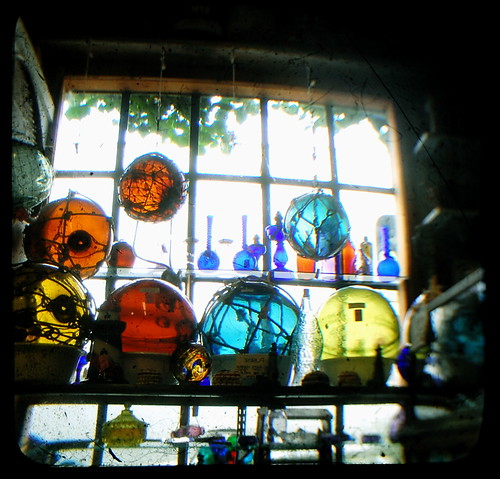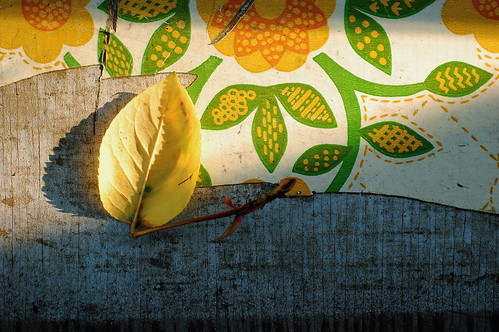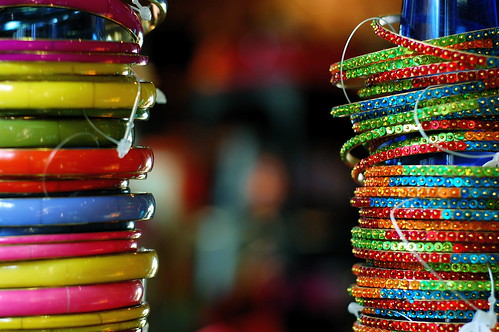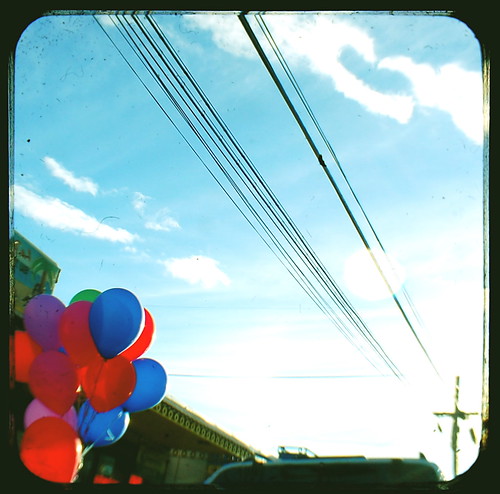
in the the realm of through the viewfinder (aka ttv) photography, I am a newbie. half the time I have no idea what I'm doing. the other half, I am totally winging it. that said, I'm happy to share my process here because sharing is nice, sharing is good and I'll not have anyone say otherwise.
what it is: the photographing of a subject through the viewfinder of any camera with another camera.
what you'll need: a camera with a viewfinder on top, a digital camera and a contraption to block the glare (which can be made from a piece of cardboard and some black duct tape).
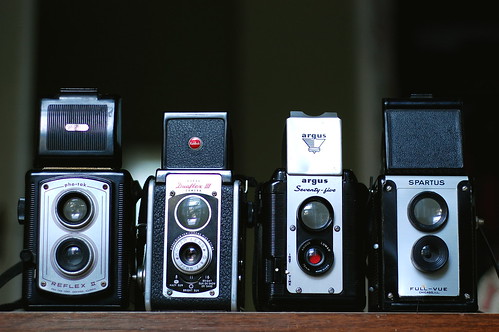
(my small army of cameras)
a word about viewfinder cameras: mostly, people use old
twin lens reflex cameras to shoot through. the most widely-used one seems to be the
kodak duaflex, which is what I started with a couple years ago. currently, I am having a little love affair with my
argus seventy-five but I'd appreciate it if you'd keep that on that DL, peeps. anyway. there are all sorts of cameras out there that can be used for ttv and all you really need is that viewfinder. of course, the most gorgeous viewfinders belong to
yashicas and
hasselblads (but if you aren't using those pretty babies to shoot film, well then I don't know what). if you're looking to score a kodak duaflex (or similar camera), your best bet is to regularly check etsy, ebay and/or keep your eyes open at antique shops, fleamarkets and the like. you can expect to pay anywhere from five to thirty dollars (sometimes a bit more) per camera, depending on the condition and model. while the prices have gone up a bit (
karen can testify to some fierce ebay wars), cameras like this are still widely available. you just have to be patient and do some looking around.
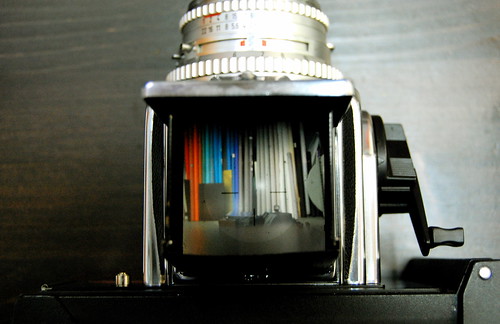
(through the viewfinder of a hasselblad)
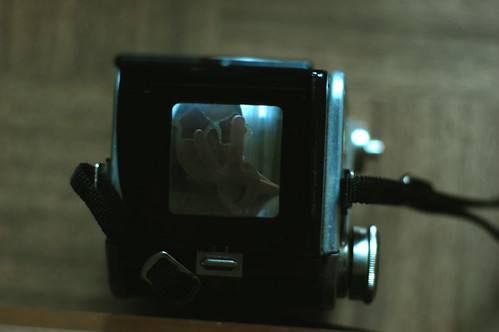
(through the viewfinder of a kodak duaflex III)
a word about digital cameras: most people get the best results using a
digital SLR. even better if you have a macro lens. I use the standard 18-55mm lens with my
nikon D40 because it's all I have and quite frankly, it gets the job done. though I am all the time salivating over fancier lenses and bigger camera bodies and I'll ditch what I have just as soon as my sugar daddy ponies up. which might be never. anyway. all you really need is a camera that will automatically focus because once you stick that lens into the ttv contraption, there's no focusing it on your own. and those of you with point and shoot cameras, take heart: when I first started experimenting with ttv, all I had was my trusty little
canon powershot A610. it's trickier, less predictable and much more fickle than using a DSLR but as long as you have a macro setting, you're good. definitely workable. witness:
my first TtV shot. also, I took
this one and
this one with the canon powershot. just sayin.
 and now, about the contraption:
and now, about the contraption: the contraption is really just a tube that helps to block the light out and prevent glare. there are some people who shoot without one and really, I'm in awe. because I have not been so successful without my wonky cardboard contraption. but you know, more power and all that. you can play around without one though I highly recommend the device. there's a
terrific template (and tutorial, natch) you can use to make a perfectly shaped device that will fit right over the body of your duaflex (or whatever you're using). but I have no patience for templates. when I am really excited about something I can barely stand to follow any sort of directions, I want to jump in right away and get going. I did not use the template. I mean, I wanted to use the template, I still want to use the template, I think maybe one of these days I probably will use the template. I so want to be a template sort of girl but I'm just not. but I want to be. I'll tell you one thing, I like the word template. it's so good. say it a couple of times. template. t e m p l a t e. see? so good.
how I made my contraption: this is the part where I wish I had neato photos and easy-to-follow steps for you. though given my previous confession, it should come as no surprise that I rocked it freestyle all the way. basically, I dumped the contents out of a mostly full cereal box, flattened it, eyeballed it a bit and then cut out a long rectangular shape that looked similar to other contraptions I'd seen online. I wrapped it around the top of the camera, played around with it until it fit my duaflex/argus just right, trimmed off the excess, taped the ends together and covered the entire thing with black duct tape. then I popped that sucker on top of the camera, secured it with a few more small pieces of tape and got serious about the shooting. no time for templates and measuring devices for me. well okay, and it shows. my contraption is the ugly duckling of ttv contraptions but she gets the job done and I love her for it. that's all that really matters anyway. if you're struggling with the contraption, gimme a holler and we'll talk. or maybe I'll break down and post laughable photos of me transforming a fruity pebbles cereal box into ttv magic. I'm not too proud, people.

(
superhero andrea hard at work)
some words about shooting: this is the fun part. but also the trickiest and potentially most frustrating part. this is where you have to let go and wholly surrender to play and experimentation. I'll tell you, it's a little awkward. especially at first. you are holding the old camera from the bottom with one hand while holding your digital camera (which is all shoved into that big cardboard device at the top) with the other hand. it looks and feels a little like you're walking around with a bazooka. then there's all the adjusting you'll have to do, the fiddling with the zoom and the auto focus. I recommend setting your camera on auto (or program) until you get the hang of it. then you can start playing around with it manually. to further complicate things, the image in the viewfinder is reversed. this makes things doubly confusing when trying to find and frame your subject. all I can say is, keep playing around. it's the only way. it'll get easier. I promise.
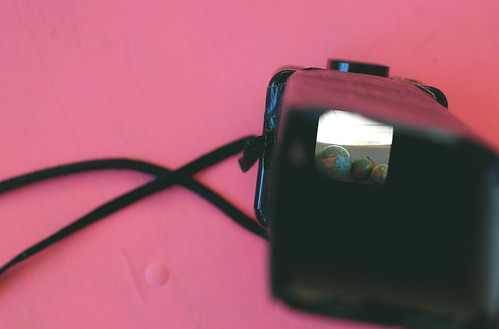 about the final step
about the final step: cropping. most of the time you won't even be able to tell what you've gotten because all you'll be able to make out is this tiny square image in a sea of black. you'll want to delete delete delete but don't. suppress the urge to delete because it's only when you start to crop the images afterwards (either in iphoto or photoshop or whatever) that you'll be able to see what you've really gotten. and that's the best part, it really is. well, that and the moment you really start to get it. and then, before you even know what's happening, you are totally and completely hopelessly hooked. so watch out. and don't say I didn't warn you. because I swear, you won't know what hit you.
and now, an obscene amount of TtV linkage, just for you:
TtV tutorial by russ morris (props to mr. morris who has mad TtV skills and way more knowledge than I do. I highly recommend you give his stuff a good read or two)
russ morris' JPG article (more good reading)
russ morris' tv spot (if you can't read well then you can watch)
photojojo's ttv bit (a different perspective plus fun to read plus more linkage)
the ttv blog (for inspiration)
the ttv flickr group (for more inspiration, plus you can join)
a nifty book you can buy (who doesn't love a book?)
next up: actually loading that argus seventy-five with re-spooled 120 film and shooting for reals. that's where I'm headed next. I'll keep you posted.
